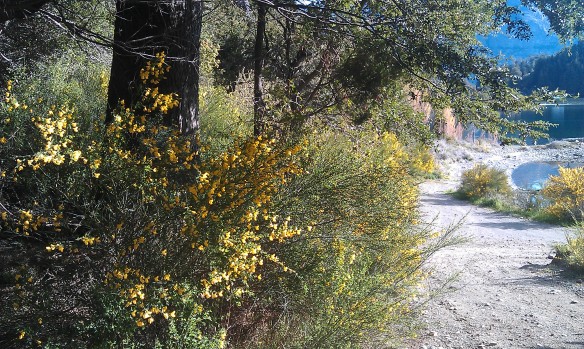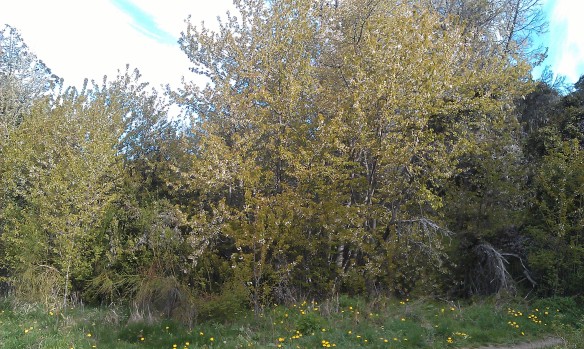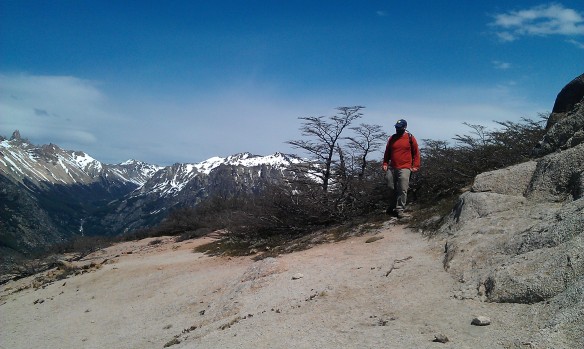Jonathan Lenoir, Maître de Conférences à l’Université de Picardie Jules Verne, s’est rendu en Argentine dans le cadre de son travail sur les invasions biologiques à hautes latitudes (relire l’article). Il y a rejoint le Dr. Aníbal Pauchard, de la Faculté des Sciences forestières de l’Université Concepción au Chili, le Dr. Martin Nuñez, du Laboratoire d’Écologie, Inibioma à Bariloche, en Argentine, Jonas Lembrechts, de l’Université d’Anvers et le Dr. Ann Milbau de l’Université de Umeà, en Suède.
« I have just spent several days in the breathtaking mountain landscapes of the Nahuel Huapi National Park (San Carlos de Bariloche, Argentina) together with Ann Milbau, Jonas Lembrechts, Anibal Pauchard and Martin Nuñez talking about plant invasion at high altitudes and latitudes. I’m still very much a novice in the field of plant invasions and thus this post might sound pretty naive to those of you who are plant-invasion geeks. Anyway, I think that I’m learning a lot by hanging around Ann, Jonas, Anibal and Martin who all know a great deal on this topic and thus I’m giving it a try. Please, correct me if I’m saying anything stupid here. One thing that I have rapidely understood is that although these cold and harsh environments are among the least invaded ecosystems in the world, nonnative plants are becoming increasingly common in these environments (Pauchard et al., 2009) and will be even more with future climate change, posing a threat to native plant species. Within the Nahuel Huapi National Park, up to 130 invasive plants have been recorded so far.
Shortly after landing in San Carlos de Bariloche, I could easily grasp the phenomenon and see by myself how important are plant invasions in mountain ecosystems such as in the Nahuel Huapi National Park and its surroundings. The Lodgepole pine (Pinus contorda),native from the western part of North America, has already rapidly expanded into the dry steppes surrounding Bariloche’s airport at the foothill of the Patagonian Andes.
As we were heading towards Bariloche, I could not miss the bright yellow colors of the Scotch broom (Cytisus scoparius) along the road. This European fellow is simply everywhere on the roadsides.
From the lakeshore, close to Bariloche, we climbed uphill within the impressive Coihue forest (Nothofagus dombeyi) which understorey was covered by a carpet of dead Caña coihue (Chusquea coleou) after a massive die-off happening some years ago. This native bamboo is flowering on a thirty-year basis, on average, triggering mice population explosions the following years due to large seed supplies.
As we moved up along the trail, I encountered plenty of our little European plant fellows playing hide and seek in the clearings, among others: Prunus avium, Sorbus aucuparia,Juniperus communis, Rosa rubiginosa, Rubus idaeus and Taraxacum officinale.
As we kept climbing upward it got less crowded with European plants and once we reached the vegetation belt of the Lenga forest (Nothofagus pumilio), only few individuals were standing here and there along the trail (Rubus rubiginosa, Taraxacum officinale andHieracium pilosella), barely visible.
Finally, once we reached the treeline, at the doorstep of the alpine vegetation belt when Lenga trees rapidly decreases in size (see the two pictures below with Martin for the scale), then I did not see any of our European fellows anymore but maybe these little guys were just hiding very well and I was just too tired after the hike.
Or, most likely, I was just too much distracted by the most beautiful native alpine plant of the area (Ranunculus semiverticillatus) to see any nonnative plant…
Thank Ann, Jonas, Anibal and Martin for the great discussions and for letting me discover a wonderful country (@Martin: you look great on the two pictures, very professional). For more information on plant invasions into mountain areas in general, have a look at the website of the outstanding mountain invasion research network (MIREN). Last but not least, I highly recommend to visit Jona’s blog which is just amazing and full of beautiful pictures, enjoy ».
http://jonathanlenoir.wordpress.com/2014/10/29/plant-invasion-in-mountain-ecosystems









